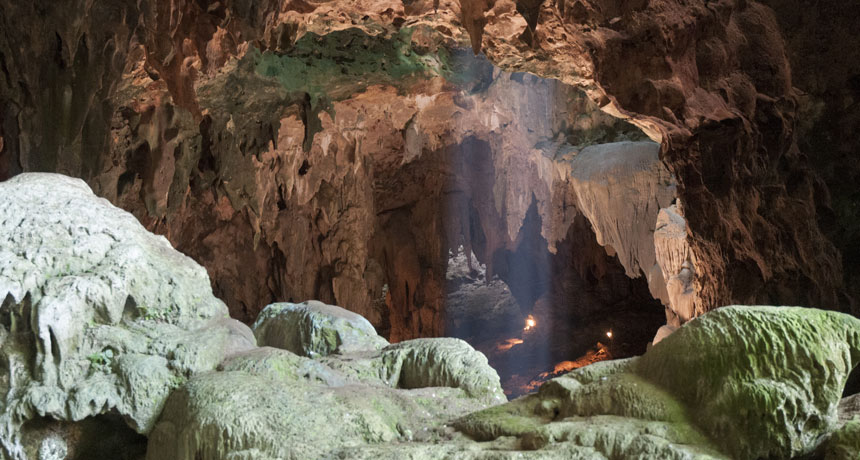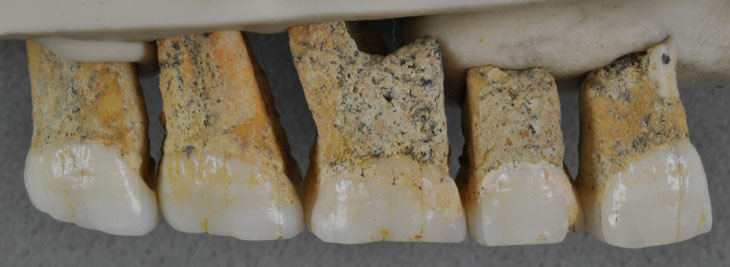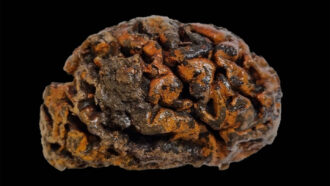Fossils from a Philippine cave may come from a new human-like species
Scientists say Homo luzonensis lived at least 50,000 years ago

Scientists think fossils from this Philippine cave were left by a previously unknown Homo species that lived at least 50,000 years ago.
Callao Cave Archaeology Project
By Bruce Bower
In a cave in the Philippines, researchers made a remarkable discovery of fossil bones and teeth. These remains appear to come from a new human-like species.
This human relative, or hominid, lived at least 50,000 years ago. Scientists have just dubbed its species Homo luzonensis (Lu-zo-NEN-sis). They took the name from Luzon, the island on which the fossil remains were found. Researchers described shared their new findings in the April 11 Nature.
Homo luzonensis lived at the same time as Homo floresiensis (Flo-res-ee-EN-sis). Nicknamed “hobbits,” those were controversial, half-sized Indonesian hominids who roamed its island of Flores.
Some of the new fossil bones are similar in shape and size to those in other Homo species. “But if you take the whole combination of features for H. luzonensis, no other Homo species is similar,” says study coauthor Florent Détroit. He’s a paleoanthropologist (PAY-lee-oh-an-throh-PAAL-oh-gizt) at the French National Museum of Natural History in Paris.
It will take more research to confirm that this is truly a new species. But if true, it would add another twist to the story of human evolution in Asia. Modern humans, Homo sapiens, reached what’s now Southern China between 80,000 and 120,000 years ago. When they got there, other members of the Homo genus were already living in East Asia and on Southeast Asian islands. As researchers gather fossils and DNA evidence, the story is becoming more complex.
What the bones say
Researchers dug in Luzon’s Callao Cave in 2007, 2011 and 2015. They found a dozen H. luzonensis fossils. These included seven teeth, five of which came from just one individual. They also found two finger bones and two toe bones. And they dug up an upper leg bone missing its ends.
To date how old the fossils were, scientists analyzed the radioactive decay of uranium in one tooth. (This element decays at a constant rate.) This suggested the bones are at least 50,000 years old. Based on that date, researchers decided a bone from another 2007 dig there also belonged to H. luzonensis. That was a foot bone found in the same cave sediment. It’s at least 67,000 years old.

In some ways, the teeth have traits seen in modern humans. But in other ways they resemble ancient, now-extinct hominids. For example, H. luzonensis had molars that were very tiny, even smaller than those in hobbits. But the molars also have some features similar to those in modern humans. Other teeth, called premolars, were relatively large in H. luzonensis. Surprisingly, these teeth had two or three roots. Those teeth in modern humans have only one root. But hominids that lived at least several hundred thousand years ago — such as Homo erectus — typically had premolars with multiple roots.
Finger and toe bones in H. luzonensis are curved. That suggests these individuals could climb trees. In this way, they would resemble hominids from at least 2 million years ago.
It’s unclear whether H. luzonensis was as small as hobbits, Détroit says. The best-preserved hobbit skeleton comes from a female. She stood only about one meter (three feet) tall. Based on the length of the Callao Cave foot bone, Détroit’s team suspects that H. luzonensis was taller than that. But these people still would have been smaller than most human adults today.
Mysterious origins
As with hobbits, the evolutionary origins of H. luzonensis are a mystery. Scientists think hobbits may have descended from groups of H. erectus that traveled the seas. Perhaps H. luzonensis did too, writes Matthew Tocheri. He’s a paleoanthropologist at Lakehead University in Thunder Bay, Canada. Tocheri wrote a commentary that was also published in the April 11 Nature.
Evidence suggests that hominids reached Luzon by around 700,000 years ago. Détroit speculates that H. erectus may have also crossed the sea to Luzon from other Indonesian islands or from mainland Asia. Then it might have evolved into H. luzonensis, with its smaller body and unusual skeletal traits. This is a process known as island “dwarfing.”
But some scientists who weren’t part of the new study say it’s too soon to call the Luzon fossils a brand-new Homo species. Détroit’s group has not extracted DNA from the fossils. Until they do, “all [evolutionary] possibilities must remain open,” says Katerina Douka. She’s an archaeologist at the Max Planck Institute for the Science of Human History in Jena, Germany.
The fossils have a mix of features that the team finds distinctive. But maybe that mix came from two or more earlier Homo species interbreeding. That would mean the fossils are hybrids, not a new species.
Or the Luzon hominids might have started out as a small population of, say, H. erectus. As they survived on the island for possibly hundreds of thousands of years, perhaps they evolved some new skeletal traits. But that wouldn’t necessarily make them a new species, says paleoanthropologist María Martinón-Torres. She directs the National Research Centre on Human Evolution in Burgos, Spain.
Such questions make the new fossils “an exciting and puzzling discovery,” Martinón-Torres says.
Scientists know for sure that the Callao Cave hominids had unusual teeth. They also had hand and foot bones built for climbing. If Luzon’s ancient Homo members all shared these traits, “then that combination is unique and unknown so far” among hominids, Martinón-Torres says. A more complete set of fossils, ideally with ancient DNA, would tell us more. Martinón-Torres says we’ll need these findings to know for sure whether our family tree has a new member.







